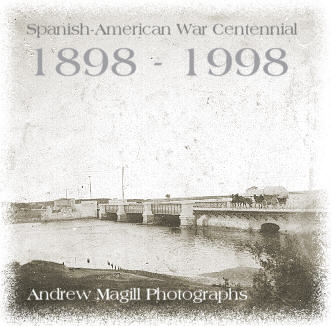The Centennial
This year find us remembering the hundred year anniversary of an all but forgotten war. Hardly anyone now stirs to the words "Remember the Maine." Yet this short-lived war launched the United States as a world power on par with the Imperial powers of Europe. On June 22, 1898, the United States landed fifteen-thousand soldiers southeast of Santiago de Cuba. The troops engaged and defeated Spanish land forces July 1 around the city. [1] An American force commanded by General Nelson Miles occupied Puerto Rico in July 1898. On July 18, the Spanish government requested a settlement with the United States. December 10, 1998 marks the centennial of the treaty ending the war with Spain, which saw the Spanish state ceding it's colonial territories of Cuba, Puerto Rico and the Philippines to the United States. This exhibit consists of the photographs attributed to Andrew Magill made during the Spanish-American War in 1898.
The War and Photography
In those days of yellow journalism, fervent patriotism and national transformation a nineteen-year-old Andy Magill answered the call of his country and perhaps thinking the war would be a great adventure, joined the ranks of young soldiers ready for a fight. His niece recalled he was a trumpeter, so perhaps he served in a military band unit. The Spanish-American war was one of the first to be covered extensively by the media. Not only was the war covered by the newspapers, they played a role in encouraging the public to support war with Spain. The conflict between the United States and Spain came about as a kind of "media war" promoted by various newspaper interests ranging from Pulitzer to Hearst owned newspapers. Their circulation was vastly increased by the sensational accounts and photographs they published. The military fought with much greater capacity than the civil war, carrying the fight to distant lands. The scope of the war helped make the American navy a dominant power in the Pacific. America would in the post-war exuberance, somewhat reluctantly, become a colonial power. You can read more about the war by visiting the Centennial site listed of the left. Many photographers were attracted to the theater of operations, often attached to various newspaper interests. Like a tourist, Andy brought at least one snapshot camera, a Kodak. It is possible that his status as a military band member may account for his having had time to photograph the war. He may have managed to bring his camera equipment with him by perhaps slipping it in with the musical instruments and band paraphernalia.
The Photographs
Although all of the photographs handed down through the Barnum family as originally being made by Andy Magill are attributed to him, this may not be entirely true. We can say with some certainty the two Kodak snapshots are by him, but the Boudoir and other cards could possibly have been purchased as souvenirs. We are not sure what level he had achieved in the art of photography at the time of his service. The Boudoir and other card photographs do seem to bear the mark of an amateur photographer. They do not contain an imprint and are somewhat crudely mounted in comparison to other commercial prints. However, many inexpensive views were produced in the nineteenth-century on poor quality card stock and just as poorly mounted. Therefore no definite conclusion can be reached.
Seven photographs survive of whatever number he brought back from the war. Six are presented here.
The Photographer
Andrew Magill's young niece, Ethel Barnum in later years remembered that he had once said Teddy Roosevelt had not charged up San Juan hill. This is likely true, since the charge took place on Kettle hill against a fortification flanking San Juan Hill. While we have Ethel's remembrance that her uncle Andy served during the war and that he was present at the Battle of San Juan Hill, record of his service has not been found. It is possible records will be found at the state level.
Andrew Magill was born on 3 Nov 1879 in Paloa, KS. He would later make several valuable and interesting family photographs, photograph a train-wreck with a mind to novelty image sales and produce a remarkable series of glass-plate images of his Paola, Kansas neighbors. After losing a leg in an accident while working at the Armour meat-packing plant in East St. Louis, he turned to photography for a living. He would briefly open his first studio operation in St. Louis where he met his death it is thought, by foul play. On 1 Jul 1908 Andy died in East St. Louis, Ill. His death remains a mystery.
